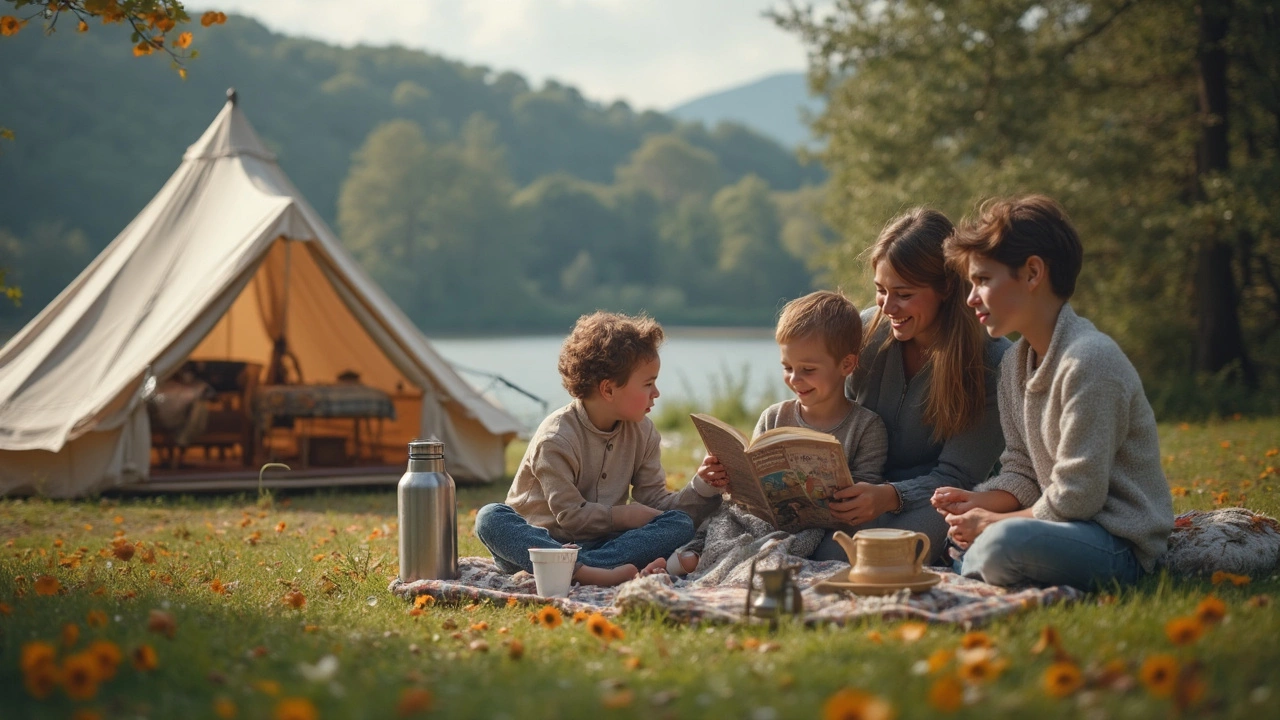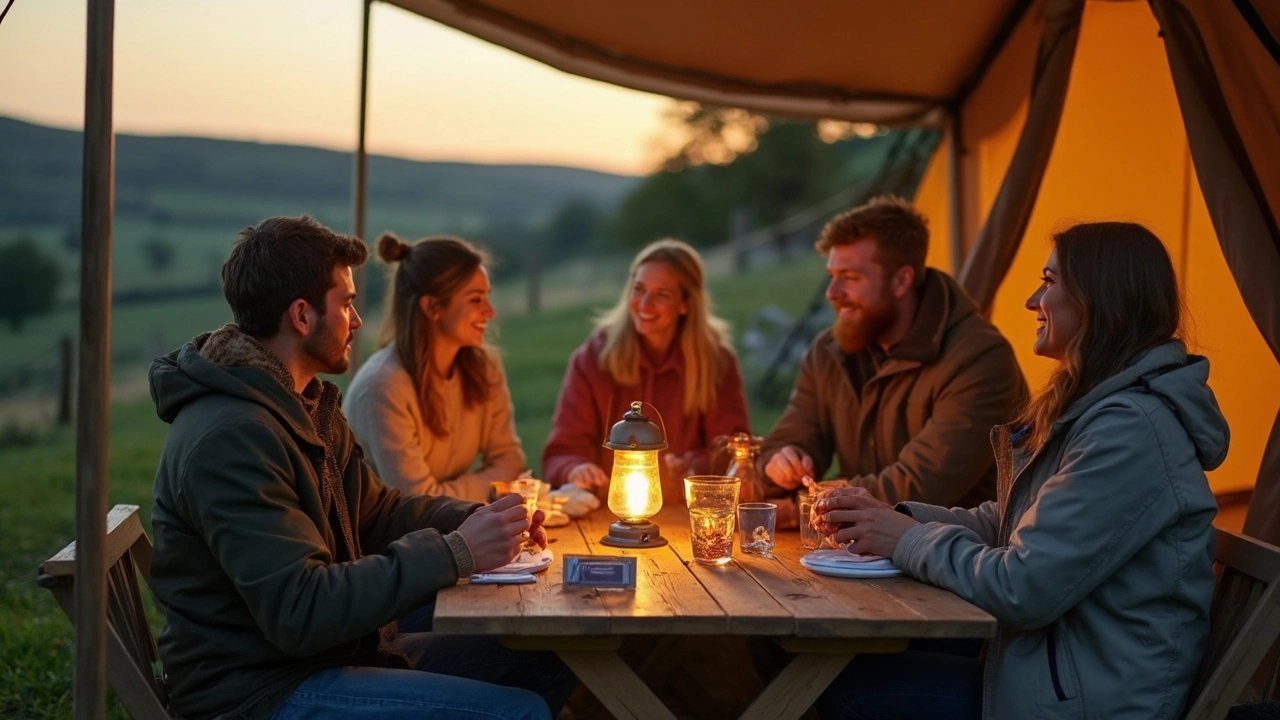Ever wondered why some campers handle surprises like sudden storms or a forgotten lighter with zero panic? There’s a trick called the rule of three, and it’s something you want in your back pocket even when you’re staying at a five-star glamping spot.
The rule of three isn’t just survivalist jargon. It’s a smart shortcut for figuring out what to take care of first when camping gets tough, whether you’re roughing it or sipping champagne under a canvas roof. Picture losing track of time, getting too cozy by the fire pit, and suddenly realizing you forgot to pack extra layers or snacks. The rule of three jumps in to help you make the right choices, fast.
This guide breaks down how the rule works and why every camper—yes, even the ones who prefer their tents with Wi-Fi—should know about it. You'll see how luxury camping isn’t just about being pampered; it’s about knowing how to turn any setback into no big deal.
- What Is the Rule of Three?
- Why Even Luxury Campers Need It
- How to Use It at Upscale Sites
- Pro Tips for Comfortable, Safe Camping
What Is the Rule of Three?
The rule of three is one of those camping tips that’s been passed around for decades, and for good reason. It’s easy to remember and cuts right to what matters most in any outdoor situation. In short, it’s a way to help you remember how long you can survive without the basics—air, shelter, water, and food—in the wild. But it’s not just about survival; it shapes how you pack, plan, and deal with surprises, even at a luxury campsite.
Here’s how the rule actually breaks down:
- You can last about 3 minutes without air.
- After 3 hours in severe weather without shelter, you’ll be in real trouble.
- Go around 3 days without water, and dehydration becomes dangerous.
- You can make it about 3 weeks without food, though you’ll feel terrible long before that.
These aren’t random numbers—they’ve been tested in real outdoor situations and accepted by search and rescue professionals. The point isn’t to push your limits, but to have a mental checklist if you ever forget something or need to step in and help. For example, if your tent blows away and a storm rolls in, shelter becomes your top priority—way before thinking about dinner.
Even at high-end sites, things can go sideways. If your glamping pod’s heat fails or you run into an unexpected storm, knowing the rule of three helps you quickly decide what to fix first. It’s about staying comfortable, yes, but also safe and calm when something doesn’t go as planned.
Why Even Luxury Campers Need It
Most people hit luxury campsites thinking every possible detail is covered. Heated tents, private chefs, and Wi-Fi can make it feel like you’re nowhere near the wild. But the outdoors has its own plan. Even the fanciest glamping spot can’t control sudden weather changes or a freak power outage. That’s why the rule of three shouldn’t just be for survivalists—it matters just as much for anyone who loves camping in style.
The basics of the rule of three help you remember what your body needs if things go off track: three minutes without air, three hours without shelter in harsh weather, three days without water, three weeks without food. You might not be stranded in Alaska, but even a short cold snap or a broken espresso machine can mess up your comfort. High-end camping gear is awesome, but it’s not magic. If your plush sleeping bag gets soaked in the rain, the best tent won’t keep you warm. Priorities and making smart choices are key.
According to the Outdoor Industry Association, the number of people choosing luxury campsites jumped over 20% in the last two years, but even seasoned glampers sometimes forget backup batteries or don’t pack for sudden temperature drops. A 2023 survey by Glamping Hub found that 30% of luxury campers had some kind of ‘unexpected issue’—from missing gear to mild hypothermia. It happens more often than people think.
"You don’t need to live off the grid to need backup plans. Nature throws curveballs at everyone—luxury or not. Knowing the rule of three keeps comfort and safety a priority," says Anna Lopez, Head Guide at Luxe Wilderness Retreat.
Whether you’re booking a bell tent with a spa tub or a safari lodge with private staff, the rule of three gives you a logic check. Ask yourself: What can I do without for three minutes, three hours, or three days? Once you answer that, you’ll know what to bring, what to ask your host, and when to push for extra services. Most importantly, you’ll stress less, which is really the whole point of camping in comfort.

How to Use It at Upscale Sites
Just because you’re glamping or staying at a luxury campsite doesn’t mean you can skip the basics. The rule of three is all about staying safe, comfortable, and smart, no matter how high-end the setup is. Here's the quick rundown if you need a refresher: You can survive roughly three minutes without air, three hours without shelter (in harsh weather), three days without water, and three weeks without food. It’s a priority checklist when things go sideways.
You might have heated yurts, catered meals, and Wi-Fi, but upmarket campsites can still run into issues—think sudden storms, power outages, or supply hiccups. Here’s how you can weave the rule of three into your experience:
- Air: It sounds obvious, but indoor fireplaces or heating in glamping tents can cause issues. Make sure your tent or cabin has good ventilation. Check carbon monoxide detectors are working, especially with indoor stoves—luxury doesn’t mean risk-free.
- Shelter: Weather can turn fast, even at polished sites. Ask staff about backup shelter plans (covered lounges, cabins, or shared spaces). Always know your nearest real shelter just in case. Keep a dry bag with essentials handy.
- Water: Upscale camps usually offer fancy water stations, but what if there’s a plumbing glitch? Ask about bottled water or backup sources. Don’t hesitate to pack a small travel purifier. Staying hydrated is still a basic rule, no matter how fancy the kitchen is.
- Food: Most glamping sites dish out some great meals. But supply delays or menu changes happen. Keep a stash of easy snacks in your cabin—think energy bars, fruit, or nut mixes. This isn’t about surviving on granola; it’s about being comfortable if things get delayed.
Luxury sites are usually prepared, but accidents and surprises don’t ask for your reservation first. Recent data from the U.S. Campground Owners Association shows 17% of premium campsites reported at least one service disruption in the last two years, most commonly due to weather.
| Backup Feature | Percentage of Luxury Camps Offering It |
|---|---|
| Emergency Shelter Access | 88% |
| On-Site Medical Kits | 81% |
| Alternative Water Supplies | 75% |
| Dedicated Food Reserves | 67% |
Before you check in, look over what your site offers beyond the Instagram-ready photos. Don’t feel awkward about asking what their backup plans involve—they’re used to it, and usually happy to explain. Staying prepared means you get to relax, enjoy the view, and not waste a minute worrying about the basics. That’s what the rule of three does: it takes the edge off, so you can make the most of your getaway.
Pro Tips for Comfortable, Safe Camping
If you want to take your camping to the next level, don’t just bring fancy gear—know how to keep safe and seriously comfy, too. The best luxury campsites can still throw curveballs at you, from cold snaps at night to a power outage that knocks out those heated floors.
First, always follow the rule of three when you pack and plan. Having a backup for warmth, hydration, and food isn’t just overkill—it’s smart. Even if the resort claims 24/7 concierge service, bring your own small essentials, like a headlamp, extra snacks, and backup batteries. Did you know the U.S. National Park Service says more than 36% of camping accidents happen because of basic oversights like running out of water or not layering right?
- Weather proofing is key. Luxury doesn’t always mean perfect climate control. Always check the weather just before you go, not just days before. Add a compact thermal blanket and a rain jacket to your go-bag, even for summer trips.
- Food and water. Treat any promises of gourmet meals as a bonus, not a guarantee. Keep a stash of high-protein snacks and a filtered water bottle. A recent Outdoor Foundation study found that 21% of high-end campers needed their own food reserves at least once due to delays or menu slip-ups.
- Stay connected and charged. Don’t trust USB plugs to always work in the wild. Power banks matter. Set your phone for low power mode, and consider a solar charger if you plan to hike away from your suite or tent.
- Know where help is. On arrival, ask staff for the fastest way to get help, not just the Wi-Fi password. Save the main office number in your contacts and memorize the nearest medical center name.
Here’s what the research shows about luxury campers’ top issues. Take a look and prep for what really happens—not just what the brochure promises.
| Common Issue | Percentage of Luxury Campers Affected |
|---|---|
| Sudden weather changes | 26% |
| Power or Wi-Fi outages | 19% |
| Running low on food/water | 15% |
| Minor injuries (scrapes, blisters) | 11% |
The takeaway: plan for hiccups. The most enjoyable trips are the ones where you don’t stress about the unexpected. A little prep means you get to enjoy the view, the hot tub, and maybe even that fancy minibar, worry-free.
